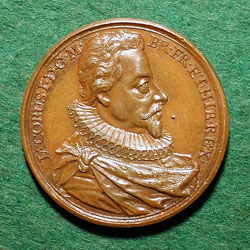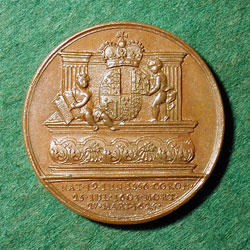|
DASSIER, Jean: England, 1731, Bronze, 41 mm
Obv: Bust of James I IACOBUS. I. D.G. M. BR. FR.
ET. HIB. REX.
Rev: Tomb with two Genii, one of whom adds the Scottish Lion to
the arms, alluding to the union of the two kingdoms, the other points to a
book, alluding to the king’s fame as an author.
Exergue: NAT. 19. IUN. 1556. CORON. 25. IUL 1603. MORT. 27
MART. 1625.
Ref: M.I. i, 237/104; Eimer 37/104; Eisler I, 262/26; Thompson 31/24
James I (1566-1625) was King of England from 1603 to 1625
and, as James VI, was King of Scotland from 1567 to 1625. He was the son of
Mary, Queen of Scots, and Henry Stewart, Lord Darnley. James acceded to the
Scottish throne as an infant on his mother's abdication. In 1589, James
married Anne of Denmark, daughter of Frederick II of Denmark. In 1603, on
the death of Elizabeth I, the last of the Tudor monarchs, James inherited
the English throne, becoming the first of the Stuart Dynasty. In 1605, a
conspiracy to blow up King James and the Parliament in response to the
anti-Roman Catholic laws was instigated. This so-called Gunpowder Plot was
foiled and James cracked down heavily on Catholics. James had a high opinion
of his own wisdom and believed that kings were divinely ordained to rule.
His insistence on the divine right of kings brought him into conflict with
his Parliaments, causing him to dissolve Parliament and rule without one.
James is remembered for the establishment of the first English colony in
America (Jamestown) and for sponsoring the Authorized, or King James'
Version of the Bible, which was published in 1611. He was succeeded by his
son Charles I.
|

